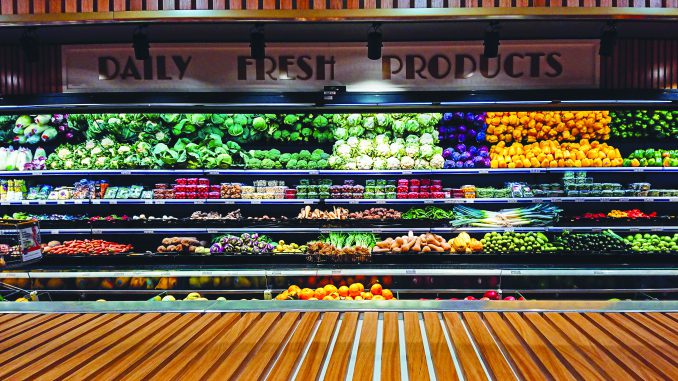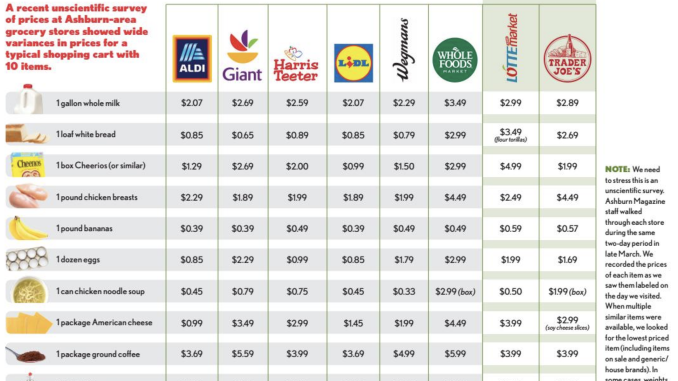
By Chris Wadsworth
Kathryn Dashiell takes her supermarket shopping seriously. Her family packs lunches every day and prepares most meals at home. So having a grocery plan pays off.
“I have four stores I go to religiously every week,” said Dashiell, who lives in Ashburn Farms with her husband and two daughters. “I go to Wegmans because they have the best produce. Everyone knows that. Another stop is Trader Joe’s because they have the fun stuff. Target sells certain things I can’t find anywhere else. And then there’s the Costco run.”
And that doesn’t count quick stops at the Giant near their home when something is needed on the fly.
Dashiell and thousands of other area residents are taking advantage of what feels like an unusual trend here in Ashburn: We have a ton of grocery stores.
EVERYWHERE YOU TURN
An unscientific count finds 14 supermarkets in the immediate Ashburn area — bordered roughly by Route 7 to the north, the Broad Run creek to the east, Brambleton to the south and Belmont Ridge Road to the west. That doesn’t include the Harris Teeter in Lansdowne or the Wegmans at Waxpool and Route 28, both of which are Ashburn-adjacent.
And these are just the larger-sized supermarkets that are part of a chain. There are also many small “mom-and-pop” grocery retailers around Ashburn.
“Twenty five years ago, it was Giant and Safeway. You didn’t have Harris Teeter or Whole Foods or Aldi or Lidl or Wegmans or Trader Joe’s in the suburbs. Now you’ve got them all here,” said Chris Netter, senior vice president of Saul Centers Inc., which owns dozens of shopping centers in the Washington area. This includes the Broadlands Village Center, the Ashburn Village shopping center and the Ashbrook Marketplace (under construction) — all in Ashburn. “Now that you have all these different types of grocery stores, you have people who do multiple store shopping,” Netter added.
National studies have borne this out.
“Most shoppers have probably between five and seven stores in their repertoire, and that includes online,” said David Fikes, vice president of communications and consumer/community affairs at the Food Marketing Institute. FMI is the largest food retailer association in the country. ““The shopper equation has gotten quite complicated,” Fikes said.
FMI reports there are three main reasons why Ashburn and other communities have seen an explosion in the number and types of grocery stores.
REASON NO. 1
One of the most critical aspects is the shrinking middle class.
“For a while — 20 years ago and more — the philosophy was play to the middle,” Fikes said. “But as the middle class has shrunk … we started seeing stores specializing — targeting the artisanal-oriented consumer that wants finer, higher-end products. Or they are playing to the other end and saying, ‘We are going to offer the best economic value that we can for our shoppers.’”
Think Whole Foods and, perhaps Wegmans, targeting the higher-end customer with their organic products, gourmet brands and large cheese and wine offerings. At the other end are Aldi and Lidl, which specialize in lower-cost, store brands with fewer choices. And in the middle — your heritage brands such as Harris Teeter, Giant and Safeway.
REASON NO. 2
Another factor affecting the number of grocery stores — the actual number of shoppers.
Fikes notes that once upon a time, grocery shopping was almost exclusively the domain of wives and mothers, but no more.
“There’s a deep increase in the number of male shoppers and families where shopping is a co-shopping arrangement. A 50-50 split between the two heads of the household,” he said. “The number of trips per family has almost doubled because you have two — sometimes three — people in the household who are doing the shopping.”
Different shoppers like different things — even in the same family — and this means more stores to serve them.
REASON NO. 3
Finally, there are more store options because the philosophy of many customers has changed in recent years.
“25 to 30 years ago, health and wellness issues started to creep in,” said Fikes, whose FMI has been studying shopping trends since the 1970s. “Then 15 to 20 years ago, we started hearing ‘How was the animal treated?’ ‘How was the worker treated?’ ‘Where is this from?’ — more esoteric questions entered into the equation.”
In other words, the meaning of the word “value” has changed. Although it was once purely economic — the lowest price — now it also has to do with the “values” that a shopper holds dear.
Think “organic,” “fair trade,” “pasture-raised” — terms we all see weekly while shopping.
“Convenience used to be which store is closest,” Fikes said. “Now it’s which one is closest that also accommodates my value system.”
LOCATION, LOCATION, LOCATION
“So weird.”
That’s how Wendy Wade describes some of the supermarket locations around Ashburn. She’s a graphic designer who lives in Brambleton with her husband, Jason, and their two children.
“It doesn’t make any sense to me how they pick their locations,” Wade said. “There are some large holes where I’m surprised that there isn’t a grocery store, and then they will put three of them in less than a mile radius.”
Common sense says that most grocery stores look for locations with lots of homes, lots of traffic passing by each day and plenty of space for parking — a spot where they can carve out and dominate a customer base from surrounding neighborhoods.
Add in a healthy, fast-growing, affluent community, and Ashburn hits most of the key markers.
But recently, some new stores in our community have surprised local residents by opening right next to other supermarkets. Take the dueling Aldi and Lidl stores in the Broadlands, which are only a block apart on either side of Claiborne Parkway.
Or how about the new Lidl store under construction near the intersection of Ashburn Village Boulevard and Russell Branch Parkway? It’s literally across the parking lot from an existing Harris Teeter.
“They are saying, ‘Try us,’” said Netter from Saul Centers, which is developing the new Lidl location. “They’re saying, ‘Come in and see how much less expensive our produce when it is just as good or better.’ They’re saying ‘Try our wine — it’s half the price of other places.’ If you’re going to all these other stores anyway, they’re saying, ‘Try us.’”
So, what does the future hold for supermarkets in Ashburn? You already know the answer.
As Ashburn expands, industry experts say expect to see even more supermarkets open, especially on the fast-growing southern side. There is already talk of a possible Aldi location between Brambleton and South Riding, as well as planned grocery stores in the new Birchwood development in Brambleton and at the Moorefield Town Square near the future Metro.
Those locations would come in handy for the Wade family, who currently mix up their shopping by hitting Walmart, Costco, Wegmans and even Lidl.
“Of course, I like Wegmans, but I save that for when I’m cooking a really nice dinner or I’m entertaining and I want to buy the cream-of-the-crop stuff,” Wade said. “And the running joke in my family is that we can go to Lidl and buy yogurt and we can also buy a power drill.”
SEVEN SECRETS TO SAVVY SUPERMARKET SHOPPING
1. Flowers and bakery items are often the first thing you’ll see in a store because they put you in a good mood and stimulate hunger.
2. Shop left to right because higher margin items are usually shelved on the right side of a section.
3. Listen to your own music on headphones while shopping because the slow elevator music in the store is meant to slow you down so you shop more.
4. Items on end caps aren’t always deals. Rather they are positioned there to encourage an impulse buy.
5. Heavy, loose fruits and vegetables — such as potatoes — are usually more expensive than the same items in bulk bags.
6. Staples such as dairy products and meats are usually at the far back of the store, in part, to make you walk past lots of other items.
7. The second and third shelves from the top are the “bullseye” for major, popular brands. Below that are colorful items that appeal to kids. And house brands and bargain items are often on the bottom shelf.
SOURCES: Today.com, RealSimple.com

